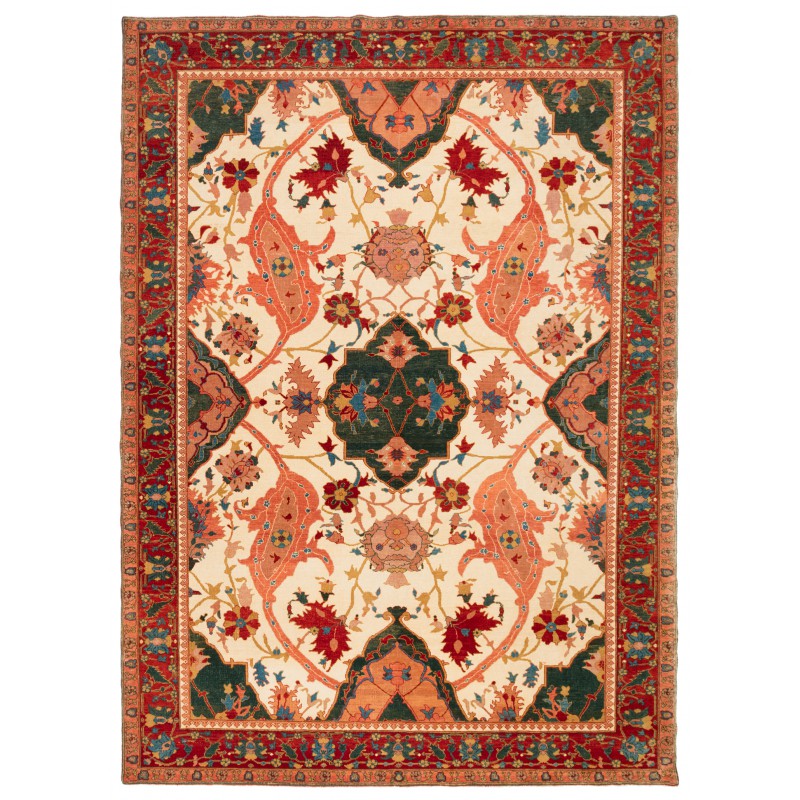
- Stock: In Stock
- Model: C28052
- サイズ: 238cm x 326cm
この絨毯は、東部クルディスタン地域のガルス(ゲロウスまたはガルス)地域で製作された19世紀の中央メダリオン絨毯です。ガルスは、ペルシャの平野に近づく丘陵地帯に位置し、古代から重要なクルド人の都市でした。ガルスはメディア・マイナーの首都であり、ガルス出身の重要な作家、科学者、政治家がサファヴィ朝に貢献し、主要な商業都市でもありました。ガルスは19世紀においてはセンナよりも人口が多かったです。西ペルシャに位置していたため、アフガニスタンの略奪やナーディル・シャーの経済的な無能さといった被害を免れることができました。18世紀には、集権的なペルシャ政府による高い税金の徴収に燃えることなく、ザンド朝の無害で分散した支配の恩恵を受けました。ガルスの優れた織物学校は、エドワーズが提案したように、神の介入による空虚なプロセスではなく、何世紀にもわたる技術と伝統の結果でした。ガルスの織物は、長い間の安定した状況から恩恵を受けました。それによって芸術が発展し洗練されるための十分な時間がありました。さらに、これは経済的に豊かな州であり、その製品を支えることができ、西アジアの主要な商業ルートに近い位置にあり国際貿易の恩恵を受けることができました。タブリーズとその市場からはそれほど遠くありませんでした。1880年、ヨーロッパとタブリーズの商人たちは、ガルスにおいて有名な「ビジャル(ビジャル)」と呼ばれる絨毯を織るためのワークショップを開設しました。これらの織物は、絨毯収集家によって長年にわたって大切に保存されてきました。ガルスの染色師によって施された鮮やかな色彩が、多花のパターンに輝く堅いウールに最も魅力的なクルド都市の織物として多くの人々に評価されています。この絨毯のデザインは、私たちのデザイナーによって解釈され、柔らかな色彩が使われています。
This is a central medallion carpet designed 19th century in Garrus ( Gerous or Garus ) region, Eastern Kurdistan area. Garrus is located in the foothills approaching the flatlands of Persia, Garrus has been a significant Kurdish city since antiquity when it was the capital of Media Minor. Important writers, scientists, and politicians from Garrus contributed to the Safavid dynasty, and it was a major commercial center. Garrus was more populous than Senna in the nineteenth century. As it was in the west of Persia, it was fortunate to escape the ravages of the Afghans and to a certain extent the economic incompetence of Nadir Shah. In the eighteenth century, it benefited from the lack of a centralized Persian government bent on collecting high taxes, and from the benign, decentralized rule of the Zands. The brilliant weaving school of Garrus, like that of Senna, did not develop in a vacuum in a process of deus ex machina as Edwards proposed but rather was the product of centuries of skill and tradition. Garrus weaving benefited from the area’s stability over the centuries, which meant that there was enough time for the art to develop and become refined. Moreover, this was a rich province whose economy could support its products, and which was located sufficiently close to the major commercial arteries of western Asia to benefit from international commerce. It was not far from Tabriz and its markets. In 1880 European and Tabriz merchants developed workshops in Garrus for weaving the famed carpets that are called “Bijar (Bidjar)” today. These weavings have been treasured and preserved down the years by rug collectors. The rich colors applied by Garrus dyers to the lustrous hard wool in multi-flowered patterns are considered by many to be the most attractive of Kurdish urban weavings. This carpet’s design shows a vigorous central medallion; quarters of the same medallion in the four corners of the field and ornamented with floral forms contrasting with the border. In the field, a rich assortment of decorative but naturalistic flowers, leaves, and palmettes. The design of the carpet is interpreted by our designers and soft colors are used for this rug.
